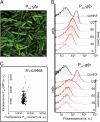Broadly heterogeneous activation of the master regulator for sporulation in Bacillus subtilis
- PMID: 20404177
- PMCID: PMC2889527
- DOI: 10.1073/pnas.1002499107
Broadly heterogeneous activation of the master regulator for sporulation in Bacillus subtilis
Abstract
A model system for investigating how developmental regulatory networks determine cell fate is spore formation in Bacillus subtilis. The master regulator for sporulation is Spo0A, which is activated by phosphorylation via a phosphorelay that is subject to three positive feedback loops. The ultimate decision to sporulate is, however, stochastic in that only a portion of the population sporulates even under optimal conditions. It was previously assumed that activation of Spo0A and hence entry into sporulation is subject to a bistable switch mediated by one or more feedback loops. Here we reinvestigate the basis for bimodality in sporulation. We show that none of the feedback loops is rate limiting for the synthesis and phosphorylation of Spo0A. Instead, the loops ensure a just-in-time supply of relay components for rising levels of phosphorylated Spo0A, with phosphate flux through the relay being limiting for Spo0A activation and sporulation. In addition, genes under Spo0A control did not exhibit a bimodal pattern of expression as expected for a bistable switch. In contrast, we observed a highly heterogeneous pattern of Spo0A activation that increased in a nonlinear manner with time. We present a computational model for the nonlinear increase and propose that the phosphorelay is a noise generator and that only cells that attain a threshold level of phosphorylated Spo0A sporulate.
Conflict of interest statement
The authors declare no conflict of interest.
Figures





References
-
- Dubnau D, Losick R. Bistability in bacteria. Mol Microbiol. 2006;61:564–572. - PubMed
Publication types
MeSH terms
Substances
Grants and funding
LinkOut - more resources
Full Text Sources
Other Literature Sources
Molecular Biology Databases

